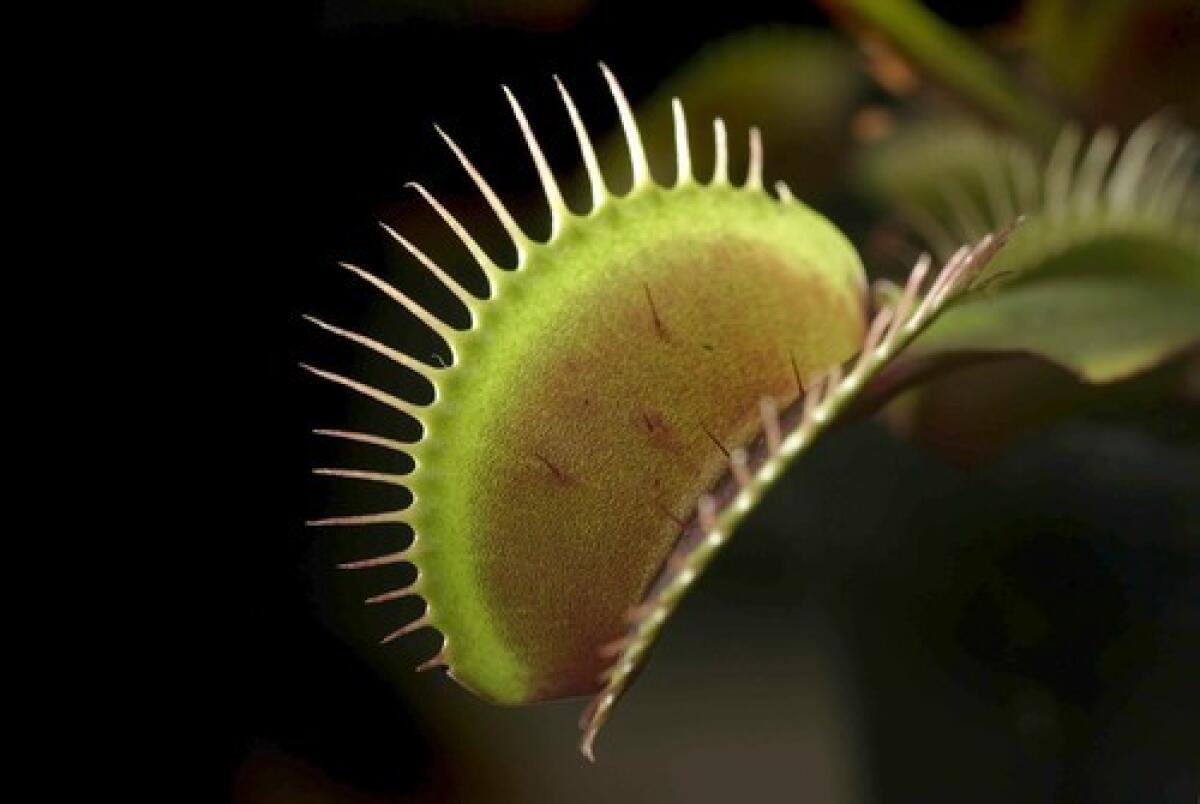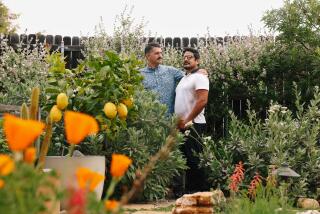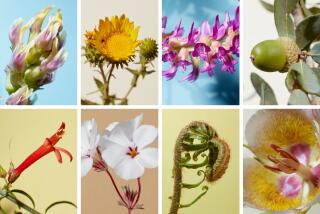Venus flytraps (and secrets to keeping them alive)

- Share via
ED READ bends over a tray of plants in the Cal State Fullerton greenhouse and gently tickles the leaf of a Venus flytrap. Twice. Two leaves snap shut in a 10th of a second. “It’s like a pseudo-memory,” he says. “Touch it once and nothing happens, but if you do it again within a few seconds, it will close.”
Attract, entrap, digest. Understanding how a Venus flytrap turns a fly into food is pretty easy. But keeping the flytrap happy and healthy? Not so much. Like the goldfish won at a charity bazaar, the plant is notoriously difficult to keep alive.
“People buy a flytrap in this little pot with a plastic dome on top, and it’s a recipe for death,” Read says.
Once an exotic rarity, flytraps are as readily available at 99-cent stores as they are in nurseries, thanks to improved tissue-culture technology. That’s good news, unless you’re a flytrap. The thud of those little pots landing in kitchen trash cans is louder than ever.
In search of the secrets to keeping the finicky plants alive, a novice needs expert advice, which brings us to the Fullerton greenhouse.
There are hundreds of flytraps here, young leaves pushing up and unfolding. Thousands more carnivorous plants keep them company: flat-leafed butterworts, bladderworts, bulbous pitcher plants and delicate sundews, their long tentacle-shaped leaves glistening with drops of digestive enzymes. The collection is one of the largest of its kind in California.
In many respects, flytraps should be easy. They don’t require fertilizing. They can survive under full sun or fluorescent lights. Unlike so many other houseplants, they can sit in a half-inch of standing water without fear of roots rotting. So what’s the problem?
“It’s the water,” says Read, explaining that the alkaline-dissolved solids in California’s tap water are poisonous to most carnivorous plants -- flytraps in particular. Flytraps come from a swamp in the Carolinas where they live in full sun, high humidity and pure water, which is the most important element.
“To help the plant thrive, give it distilled or reverse osmosis water,” Read says. “Even rainwater.”
Dry air, especially Santa Ana winds, can damage plants quickly. Those kept indoors should be far away from heaters or air conditioning vents.
Part of Read’s collection came from Forbes Conrad, a 22-year-old Moorpark College student who has been enamored of carnivorous plants for nearly half of his life. He insists they are not hard to grow or propagate. Indeed, understand the plants’ proclivities and it’s easy to wind up with too large a collection. At one time he had 400 pitcher plants in his backyard and a home-built bog.
“It’s like having a pet,” he says. “You have to watch them. You only need to repot them when they get overcrowded. If you put a dead fly in a flytrap, you’ll have to massage the hairs to get them to close.”
When gardeners have mastered flytraps and are ready for more expensive and dramatic species, pitcher plants are often the choice. Some tropical varieties produce football-sized jugs with sweet-smelling nectar at the top, a waxy surface and downward sloping hairs that lead to a pool of water and digestive fluids. At least one has been found trying to digest a rat.
“These plants aren’t boring,” Read says. “They aren’t just greenery, a flower. They actually do something. However I don’t usually invite girls over to my house to feed the plants. It’s a mood killer, right there.”
Although some collectors amass huge collections, grower Ivan Snyder has built a reputation for having a small but impeccable assortment in his Inglewood apartment. Among members of the Los Angeles Carnivorous Plant Society, Snyder is known as Dr. Frankensnyder for his ability to crossbreed and for the health and excellence of his specimens.
His collection is smaller than usual now, only 16 plants -- a few flytraps, sundews (his favorites) and an Australian pitcher plant. They’re all kept indoors, arranged on trays underneath two 4-foot cool-light fluorescent bulbs. Beneath the trays are his tools: a jeweler’s magnifying headset, loupes, tweezers, tiny knives and clippers. He also has vials of food, including dried shrimp, live wingless fruit flies and vitamin-enriched freeze-dried flies. He sometimes prepares a diluted Miracle-Gro solution, which he squirts onto a fly with a syringe before dropping it onto a leaf.
“People tend to go overboard with this hobby, but I don’t do that,” he says. “It’s too many mouths to feed.”
A collector for 20 years, Snyder says he started like everyone else. He got a flytrap from a nursery, gave it tap water and watched it die after a few months. Once he found out about using pure water, his plants thrived. He’s had one flytrap for seven years.
Collectors typically don’t think of them as plants, he says, because they act more like animals.
“They take the place of pets, but they’re not as messy, and if they die, they don’t smell bad,” he says. “They don’t make any noise -- all the benefits of pets but none of the downside.”
Venus flytraps are just the start. Get cozy with the Cal State Fullerton greenhouse’s carnivorous plants, some of which are surprisingly beautiful, in the photo gallery accompanying this article: Venus flytraps and other carnivorous plants.






